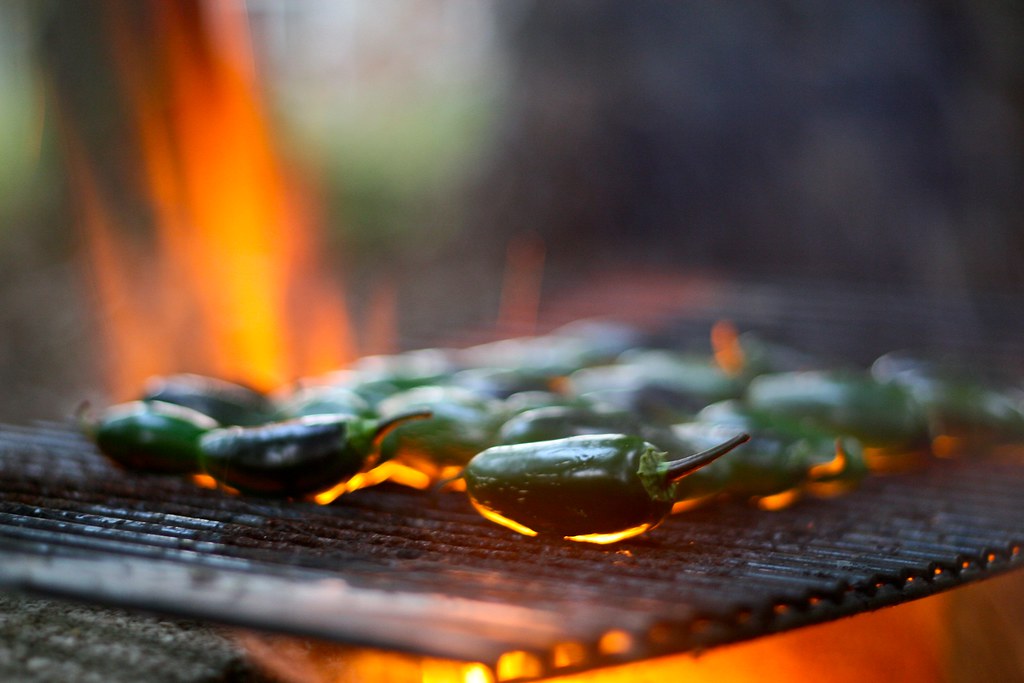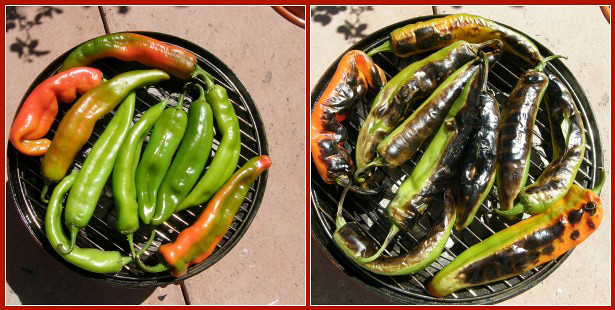… and conjure up something delicious with them
Roasting chilies and peppers make the pods – botanically actually berries – even tastier: On the one hand, the sometimes somewhat tough skin can be peeled off, and on the other, delicious roasted aromas are formed. So how to roast chili peppers?

In the U.S. Southwest, especially in the state of New Mexico, various chile varieties have been specially bred for roasting, from mild to good hot. The skinned pods are then processed in a variety of ways. In New Mexico, roasted green chiles are also a vegetable garnish, like Brussels sprouts here.
In front of supermarkets, at roadside stands, and at festivals, people buy 20 pounds of fresh green chiles (spelled with an “e” here); they are quickly roasted in rotary drums over powerful propane burners in front of customers.
They’re also used to make Green Chile Stew, Chiles Rellenos (stuffed chiles), hearty salsa and spice up ordinary hamburgers into hearty “Green Chile Burgers.” CHILI BARBECUE even has a recipe for a delicious grilled “Green Chile Pizza”.

Homegrown “New Mexican” chile varieties such as Anaheim, Sandia, Big Jim, or Ortega can also be used in this way. And, of course, varieties you’ve picked up at your local farmer’s market, from Italian Peperone to Greek Korno and other pointed peppers. No matter which chili variety you take – in any case, choose only crunchy fresh fruit.

You can also usually find them at Turkish vegetable markets. Fleshy varieties, i.e. less thin-walled chilies such as Cayenne or Thai, are particularly suitable.
The trick here is to roast the chilies quickly over high heat, turning frequently, until blistered all around – this should only take a few minutes, as you want to blister the outer skin but not cook the flesh. Don’t worry if the skin turns very black in the process, that’s just on the outside. Roasting can be done on a gas grill, or with very hot embers (briquettes) on a charcoal grill.

Individual chilies can also be handled with a small gas burner, such as those used for creme brulee. Be sure to use tongs, otherwise, the skin on your fingers will also blister!
Don’t worry if the pods turn almost black on the outside – the meat underneath stays nice and juicy.

Afterward, the hot chilies then immediately go into a paper or plastic bag to “sweat” for 10-15 minutes. After this cure, the tough transparent outer skin can be easily peeled off.

Contrary to what you may sometimes read, this should not be done under running water – you would wash away valuable aroma! Depending on how you use them, you may want to remove the insides.
Depending on the intended use, leave the roasted and skinned pods whole, de-stem and dice them, or cut them lengthwise, remove the seeds and cut “fillets”.

Then the chilies are portioned into freezer-safe plastic bags or containers and frozen after they have cooled completely. The diced chilies are suitable for chili con carne, for example, or – a favorite in the U.S. Southwest – as a side dish for scrambled eggs for breakfast. The strips are also suitable as a garnish and for many recipes that call for New Mexican chiles as an ingredient. Frozen, they will easily keep for a year or more.
In addition to “Green Chile”, you can of course roast red-ripe ones; these will be even sweeter.
The filet strips are just right for Green Chile cheeseburgers on the grill, they are also perfect as a savory side dish or for the Mediterranean antipasti buffet, like we got them at the Peperoncino Festival in Diamante:

This is where “Dolce Calabrese” come in, sort of the southern Italian counterpart to New Mexican Green Chiles. Not quite as meaty as the New Mexicans, but also very tasty.
Our tip: Try out the chili roasting process! Roasted chilies can also be used to make delicious salsas. The whole pods can be filled after thawing, for example for the famous Chiles Rellenos (chilies filled with cheese, meat or vegetarian).
